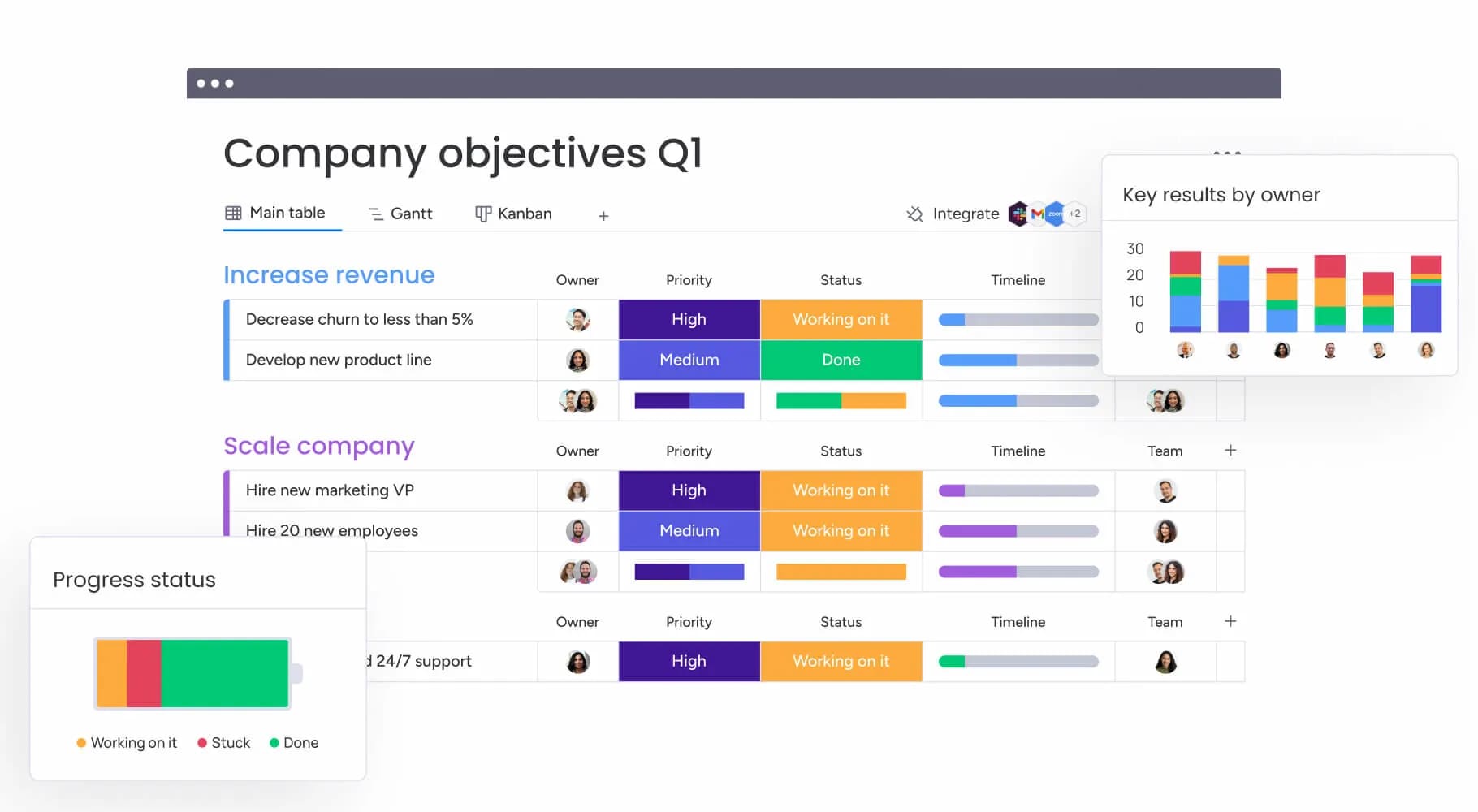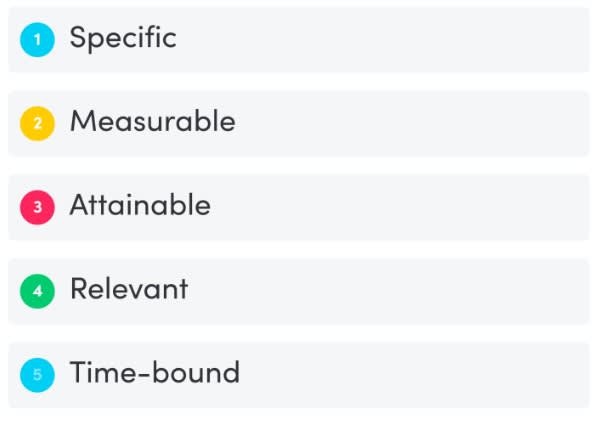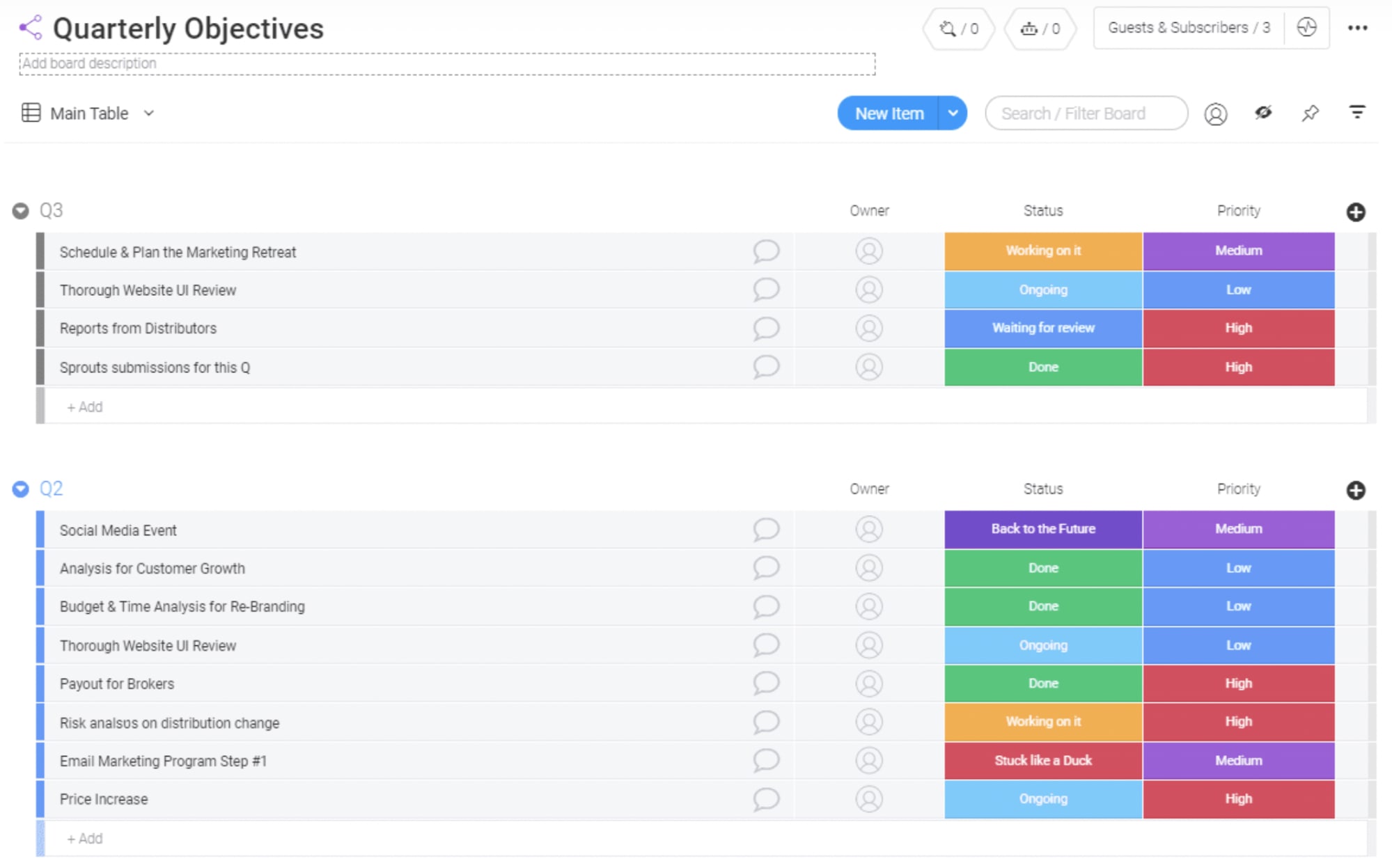Setting ambitious goals is powerful, but without the right structure, even the most thoughtful strategies can lose momentum. When teams struggle to connect long-term objectives with daily work, priorities blur and progress slows.
Goal setting templates bring that structure back. They translate vision into action by outlining clear, measurable steps that keep everyone aligned on shared outcomes. With the right framework, teams can define priorities, assign ownership, and track progress in ways that feel both consistent and adaptable.
The following templates showcase practical formats for strategic planning, team alignment, and individual development. Each one helps bridge the gap between intention and execution: making it easier to stay focused, agile, and on track in 2025.
Key takeaways
- Turn ideas into action: goal setting templates transform vague objectives into structured plans with clear deadlines, metrics, and accountability.
- Select the right format: choose templates that match your team size, update rhythm, and collaboration style. Digital versions work best for teams, while printable ones suit individual planning.
- Connect goals to execution: monday work management links objectives directly to daily workflows, tracking progress automatically and offering AI-driven insights to keep everything on course.
- Include essential elements: effective templates feature specific goals, realistic timelines, measurable metrics, defined actions, and clear ownership.
- Keep goals dynamic: review and adjust quarterly to stay aligned with shifting priorities, and schedule regular check-ins to maintain momentum.
What are goal setting templates?
Goal setting templates provide the structure teams need to move from intention to execution. They bring clarity to the planning process by capturing goals, timelines, action steps, and success metrics in one organized space.
Research shows that people who document their goals are far more likely to achieve them, and templates make that process simple and repeatable. Instead of starting from scratch each time, they offer a framework that turns big ideas into measurable progress.
Every effective goal setting template includes the following core components:
- Goal statement: the specific outcome you aim to achieve.
- Timeline: start and end dates, along with key milestones.
- Success metrics: measurable indicators that track progress.
- Action steps: the tasks required to reach your goal.
- Accountability: clear ownership for each part of the plan.

Why you should use goal setting templates for your planning
Goal setting templates bring structure and clarity to planning, turning ambitious objectives into measurable outcomes. With a consistent framework, teams can stay aligned, meet deadlines, and maintain ownership over their results.
Consistency is what makes these templates powerful. When every goal follows the same format, progress becomes easier to track and success easier to replicate. As organizations grow, this alignment matters even more. A recent report found that only 43% of employees in large enterprises understand how their success is measured. Another 2024 study showed that when employees see clear alignment between personal and business goals, they are 35% more efficient and productive.
Structured goal planning helps close that gap by ensuring everyone works toward shared priorities. It delivers:
- Standardized processes: a unified approach to setting and tracking goals.
- Time savings: less time spent recreating planning documents.
- Progress visibility: clear insight into milestones and performance.
- Scalability: consistent methods that expand easily across teams.
Work management platforms such as monday work management take this a step further by turning static templates into dynamic systems that update automatically, send reminders, and surface insights to improve future planning.
15 essential goal setting templates for every business need
Every organization approaches goal setting differently, but the most successful teams rely on structure to keep priorities clear and progress measurable. Goal setting templates provide that structure by helping teams define objectives, assign ownership, and track results consistently.
The templates below cover a range of planning needs, from company-wide strategy to individual development. Each one is designed to support specific goals while keeping teams aligned on what matters most.
1. SMART goals worksheet template
This template walks you through making SMART goals that are Specific, Measurable, Achievable, Relevant, and Time-bound. Each section includes prompts and examples to guide your thinking.
Best suited for: anyone new to structured goal setting or teams establishing their first planning process.
2. OKR planning template
OKRs balance ambitious objectives with concrete key results. This template helps you aim high while defining exactly how you’ll measure success.
Best suited for: fast-growing companies and teams focused on innovation.
3. Annual business goals template
Connect your long-term vision to quarterly milestones. This template keeps teams aligned on priorities throughout the year.
Best suited for: executive teams and department heads planning strategic initiatives.
4. Quarterly goal tracker template
Break big annual goals into manageable chunks with a goal tracker. Regular checkpoints help you adjust course before small issues become major problems.
Best suited for: teams in dynamic environments where priorities shift regularly.
5. Team goal alignment worksheet
Ensure individual efforts support team objectives. This template maps dependencies and highlights where collaboration is needed.
Best suited for: cross-functional teams working on connected projects.
6. Project goals dashboard template
See how individual projects ladder up to business objectives. Real-time tracking shows which initiatives drive the most value.
Best suited for: project managers overseeing multiple initiatives.
7. Employee goal development template
Structure performance conversations around growth objectives. Sections for skills, career planning, and measurable outcomes guide productive discussions.
Best suited for: managers conducting performance reviews and career planning.
8. Personal goal setting worksheet
Plan your own professional development plan with sections for reflection, skill building, and action planning.
Best suited for: individual contributors focused on career growth.
9. Department goals and objectives template
Cascade organizational priorities down to functional teams. Maintain alignment while preserving departmental autonomy.
Best suited for: department managers translating strategy into operations.
10. Strategic planning goals template
Define strategic goals with sections for market analysis, competitive positioning, and resource allocation.
Best suited for: C-suite executives and senior leadership teams.
11. Weekly goal planner template
Set and track short-term goals that connect to larger goals. Weekly reviews keep momentum strong.
Best suited for: individuals and small teams who benefit from frequent check-ins.
12. Goal progress tracking template
Monitor advancement with visual indicators and early warning systems for at-risk objectives, using a success plan template to stay on track.
Best suited for: anyone responsible for ensuring goals stay on track.
13. Client project goals sheet
Align client expectations with deliverables. Transparent success criteria keep everyone satisfied.
Best suited for: agencies, consultants, and client-facing teams.
14. Resource planning goals template
Match goals to available budget, people, and tools. Capacity planning prevents overcommitment.
Best suited for: operations managers balancing multiple resource demands.
15. AI-enhanced goal generator template
This template uses artificial intelligence to turn past results into future direction. By analyzing historical data and performance patterns, AI highlights trends, uncovers gaps, and suggests realistic objectives.
Within platforms like monday work management, these insights help teams refine their planning process and set goals that are both ambitious and achievable.
Best suited for: data-driven organizations looking to optimize their planning process.

How to choose the right goal template format
The format you choose for goal setting affects how effectively teams plan, collaborate, and track results. A good fit keeps goals visible, updates easy, and accountability clear.
When evaluating your options, consider:
- Team size: small teams can use simpler setups; larger ones need shared access and version control.
- Update frequency: fast-moving projects benefit from real-time editing.
- Integration needs: templates should connect smoothly with your existing systems.
- Reporting requirements: detailed analysis requires built-in calculation or visualization tools.
These factors will help you decide whether a digital or printable template works best, and whether your team needs a collaborative or individual format.
Digital vs printable goal sheets
Digital templates excel at collaboration and automation. Multiple people can update progress simultaneously, calculations happen automatically, and integrations keep data flowing between systems.
Printable versions still serve important purposes. Use them for:
- Workshop sessions: when teams need to brainstorm without screens.
- Personal reflection: for individual planning and thinking time.
- Offline environments: where technology access is limited.
The most effective approach often combines both. Start planning on paper, then transfer to digital systems for tracking and collaboration.
Collaborative vs individual goal templates
Team templates need features that individual ones don’t. Shared access, commenting, and version control become essential when multiple people contribute.
Individual templates can stay simpler. Focus on personal reflection and progress tracking without the overhead of multi-user coordination.
Even individual goals benefit from occasional sharing. Build in checkpoints for manager feedback or peer accountability.
5 steps to creating your own goal setting template
Building an effective goal setting template starts with clarity and structure. The process involves defining what to track, how to measure success, and who is responsible for keeping progress on course.
Follow these five steps to design a template that keeps your goals focused, measurable, and connected to daily execution.
Step 1: define your goal categories
Start by listing the types of goals your organization sets most often. Common categories include:
- Financial: revenue targets, cost reduction, profit margins.
- Operational: process improvements, efficiency gains, quality metrics.
- Strategic: market expansion, product launches, competitive positioning.
- Development: skill building, leadership growth, team capabilities.
Each category needs different tracking approaches. Financial goals require quantitative metrics. Development goals might use qualitative assessments alongside numbers.
Step 2: select measurable success metrics
Choose indicators that actually show progress. Vague metrics lead to vague results and can harm morale, as employees who understand how success is measured are a lot more likely to feel motivated.
Good metrics share these qualities:
- Specific: consider metrics like “increase customer satisfaction score to 4.5” not “improve satisfaction”.
- Accessible: be sure you can actually measure them with current systems.
- Relevant: ensure they matter to stakeholders and connect to business outcomes.
- Timely: are updates available when you need them?
Also remember to include both leading and lagging indicators. Leading indicators predict future success whilst lagging indicators confirm past performance.
Step 3: map timeline and key milestones
Divide large goals into clear phases, each with its own deadline and success criteria. Include buffer time for changes in priorities, dependencies, or resource availability that could affect delivery.
Work management platforms such as monday work management make timelines easier to manage by visualizing dependencies, highlighting potential delays, and showing how shifts in one area impact the overall plan.
Step 4: design progress tracking systems
Effective tracking keeps goals visible and accountability clear. Your system should make progress easy to understand for everyone involved.
To create a reliable tracking setup:
- Use visual cues: progress bars, color statuses, and dashboards help teams see updates instantly.
- Automate data updates: connect existing systems to reduce manual work and improve accuracy.
- Adapt to different audiences: executives need high-level summaries, while team members rely on detailed task views.
Step 5: Build accountability checkpoints
Finally, schedule regular reviews throughout the goal timeline. Weekly team check-ins, monthly progress reports, and quarterly strategy sessions each serve different purposes.
Assign clear ownership for every element. When everyone thinks someone else is responsible, nothing gets done.
Create escalation paths for when things go off track. Teams need to know when and how to ask for help.

Best practices for effective goal setting templates
Success requires more than good templates (you’ll also need consistent processes that keep goals active in daily work).
Regular review cycles create accountability. Set a rhythm that matches your business:
- Weekly: for fast-moving teams and short-term objectives.
- Monthly: for departmental goals and ongoing initiatives.
- Quarterly: for strategic objectives and long-term projects.
Stakeholder involvement prevents surprises so be sure to clude relevant people from the start to surface concerns early and build buy-in.
How do you know when goals need adjustment? Watch for these signals:
- Consistent missed milestones: the timeline was too aggressive.
- Changed business priorities: the goal no longer serves its purpose.
- Resource constraints: you don’t have what you need to succeed.
- New opportunities: a better path to the outcome emerges.
By leveraging sophisticated platforms like monday work management you can make these adjustments seamless: update timelines, reassign resources, and notify stakeholders without starting over.
Transform your goal setting with monday work management
Traditional goal setting fails when objectives live separately from daily work. Teams set ambitious targets, create detailed plans, then struggle to maintain momentum as operational demands take over.
monday work management solves this by embedding goals directly into workflows. Your objectives, projects, and daily tasks live in one connected system, helping your team achieve professional goals faster.
The platform delivers several key advantages for goal management:
- Automated progress tracking: updates flow from project work to goal dashboards automatically.
- Cross-departmental visibility: see how team goals align and where dependencies exist.
- AI-powered insights: get recommendations for optimizing goals based on performance data.
- Template customization: build workflows that match your exact planning process.
Eliminate goal tracking busywork with advanced automation
Keep your team focused on achieving goals rather than reporting on them with automations that handle the administrative work. Set up triggers that instantly update goal progress when related tasks change status.
- Status-based notifications: alert stakeholders when goals reach critical thresholds.
- Conditional workflows: trigger different actions based on goal performance.
- Time-saving recipes: combine multiple automations to create sophisticated goal tracking systems.
Over 200 integrations that connect goals to every business tool
Eliminate silos by bringing data from all your tools into your goal management system. Pull metrics directly from the platforms your teams already use to create a single source of truth.
- CRM connections: link sales goals to real-time customer data.
- Marketing platform sync: connect campaign metrics to strategic objectives.
- Financial tool integration: align budget tracking with financial targets.
Powerful AI features that transform goal planning
AI capabilities add another layer of intelligence to your goal setting process. AI Blocks can analyze goal descriptions, categorize objectives by priority, and summarize complex plans for executive communication.
- Smart goal suggestions: get AI-generated objectives based on business priorities.
- Predictive analytics: forecast goal outcomes based on current progress.
- Natural language processing: turn conversation into structured goal frameworks.
Dynamic goal visualization that drives team motivation
Dynamic visualization turns static goals into living, trackable progress. By combining automation with real-time insights, teams can stay motivated, identify risks early, and make smarter adjustments along the way.
- Real-time dashboards: track progress instantly with clear visual indicators.
- Automated risk flagging: spot objectives that may fall behind before they impact delivery.
- Resource allocation insights: understand where to focus effort for the greatest impact.
With monday work management, goal visualization becomes part of daily execution — helping teams see momentum build, celebrate wins, and stay aligned on shared outcomes.
Frequently asked questions
How often should I review and update my goal setting templates?
Review your goal setting templates quarterly to ensure they match current business needs. This timing allows you to gather meaningful data about what’s working while staying responsive to changing priorities.
Can goal setting templates work for remote teams?
Goal setting templates are especially valuable for remote teams because they create structure and visibility across locations. Digital templates with collaboration features ensure everyone stays aligned regardless of time zone.
What’s the difference between goals and objectives in templates?
Goals vs objectives represent broad outcomes you want to achieve versus specific, measurable steps toward those goals. Templates should distinguish between these levels to maintain strategic alignment.
How do I align individual goals with company objectives using templates?
Effective templates include sections that explicitly link individual contributions to company objectives. Start with organizational priorities, then cascade down through departments to individual roles.
Should I use different templates for short-term versus long-term goals?
Different timeframes need different template structures because short-term goals require detailed task lists while long-term goals need flexibility for changing conditions. Use specialized templates for each.
What makes a goal setting template effective for beginners?
Beginner-friendly templates include clear instructions, relevant examples, and simple frameworks like SMART goals. They guide users through each step without overwhelming them with options.
 Get started
Get started


